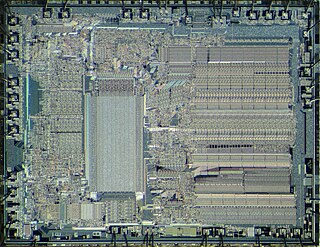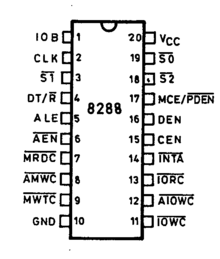
Industry Standard Architecture (ISA) is the 16-bit internal bus of IBM PC/AT and similar computers based on the Intel 80286 and its immediate successors during the 1980s. The bus was (largely) backward compatible with the 8-bit bus of the 8088-based IBM PC, including the IBM PC/XT as well as IBM PC compatibles.

The Intel 80286 is a 16-bit microprocessor that was introduced on February 1, 1982. It was the first 8086-based CPU with separate, non-multiplexed address and data buses and also the first with memory management and wide protection abilities. The 80286 used approximately 134,000 transistors in its original nMOS (HMOS) incarnation and, just like the contemporary 80186, it can correctly execute most software written for the earlier Intel 8086 and 8088 processors.

The Intel 8080 ("eighty-eighty") is the second 8-bit microprocessor designed and manufactured by Intel. It first appeared in April 1974 and is an extended and enhanced variant of the earlier 8008 design, although without binary compatibility. The initial specified clock rate or frequency limit was 2 MHz, with common instructions using 4, 5, 7, 10, or 11 clock cycles. As a result, the processor is able to execute several hundred thousand instructions per second. Two faster variants, the 8080A-1 and 8080A-2, became available later with clock frequency limits of 3.125 MHz and 2.63 MHz respectively. The 8080 needs two support chips to function in most applications: the i8224 clock generator/driver and the i8228 bus controller. The 8080 is implemented in N-type metal–oxide–semiconductor logic (NMOS) using non-saturated enhancement mode transistors as loads thus demanding a +12 V and a −5 V voltage in addition to the main transistor–transistor logic (TTL) compatible +5 V.

The 8086 is a 16-bit microprocessor chip designed by Intel between early 1976 and June 8, 1978, when it was released. The Intel 8088, released July 1, 1979, is a slightly modified chip with an external 8-bit data bus, and is notable as the processor used in the original IBM PC design.

The Intel 8088 microprocessor is a variant of the Intel 8086. Introduced on June 1, 1979, the 8088 has an eight-bit external data bus instead of the 16-bit bus of the 8086. The 16-bit registers and the one megabyte address range are unchanged, however. In fact, according to the Intel documentation, the 8086 and 8088 have the same execution unit (EU)—only the bus interface unit (BIU) is different. The 8088 was used in the original IBM PC and in IBM PC compatible clones.

The Intel 386, originally released as 80386 and later renamed i386, is a 32-bit microprocessor designed by Intel. The first pre-production samples of the 386 were released to select developers in 1985, while mass production commenced in 1986. The processor was a significant evolution in the x86 architecture, extending a long line of processors that stretched back to the Intel 8008. The 386 was the central processing unit (CPU) of many workstations and high-end personal computers of the time. The 386 began to fall out of public use starting with the release of the i486 processor in 1989, while in embedded systems the 386 remained in widespread use until Intel finally discontinued it in 2007.

The Intel 80186, also known as the iAPX 186, or just 186, is a microprocessor and microcontroller introduced in 1982. It was based on the Intel 8086 and, like it, had a 16-bit external data bus multiplexed with a 20-bit address bus.

The Intel 8085 ("eighty-eighty-five") is an 8-bit microprocessor produced by Intel and introduced in March 1976. It is the last 8-bit microprocessor developed by Intel.

The NEC V20 is a microprocessor that was designed and produced by NEC. It is both pin compatible and object-code compatible with the Intel 8088, with an instruction set architecture (ISA) similar to that of the Intel 80188 with some extensions. The V20 was introduced in March 1984.

The Intel 8087, announced in 1980, was the first floating-point coprocessor for the 8086 line of microprocessors. The purpose of the chip was to speed up floating-point arithmetic operations, such as addition, subtraction, multiplication, division, and square root. It also computes transcendental functions such as exponential, logarithmic or trigonometric calculations. The performance enhancements were from approximately 20% to over 500%, depending on the specific application. The 8087 could perform about 50,000 FLOPS using around 2.4 watts.

The Intel 8259 is a programmable interrupt controller (PIC) designed for the Intel 8085 and 8086 microprocessors. The initial part was 8259, a later A suffix version was upward compatible and usable with the 8086 or 8088 processor. The 8259 combines multiple interrupt input sources into a single interrupt output to the host microprocessor, extending the interrupt levels available in a system beyond the one or two levels found on the processor chip. The 8259A was the interrupt controller for the ISA bus in the original IBM PC and IBM PC AT.

The Intel 8255 Programmable Peripheral Interface (PPI) chip was developed and manufactured by Intel in the first half of the 1970s for the Intel 8080 microprocessor. The 8255 provides 24 parallel input/output lines with a variety of programmable operating modes.

Intel 8237 is a direct memory access (DMA) controller, a part of the MCS 85 microprocessor family. It enables data transfer between memory and the I/O with reduced load on the system's main processor by providing the memory with control signals and memory address information during the DMA transfer.

The Intel 8089 input/output coprocessor was available for use with the 8086/8088 central processor. It was announced in May 1979, but the price was not available at that time. It used the same programming technique as 8087 for input/output operations, such as transfer of data from memory to a peripheral device, and so reducing the load on the CPU. This I/O processor was available in July 1979 for US$194.20 in quantities of 100 or more. Intel second sourced this coprocessor to Fujitsu Limited.

The 8251 is a Universal Synchronous/Asynchronous Receiver/Transmitter (USART) packaged in a 28-pin DIP made by Intel. It is typically used for serial communication and was rated for 19.2 kilobits per second signalling rate.

The Intel 8282 is an 8-bit latch, which was developed primarily for the Intel-8086/8087/8088/8089-processors. The component comes in 20-pin DIL package. It was licensed to companies such as NEC and Siemens. With the ROM-less versions of the MCS-48 and MCS-51 microcontroller compact systems with external ROM / EPROM can be realized. The 8282 can also be used in 8080/8085-systems replacing the 8212. If OE is connected to GND, the chip is selected. STB (Strobe) is connected to the pin ALE of the processor and takes over the address data from the multiplexed address-/databus. The 8283 has the same functionality, but the data is inverted. In 1980 the Intel 8282 and I8282 version was available for 5.55 USD and 16.25 USD in quantities of 100 respectively.

The Intel 8283 is an 8-bit latch, which was developed primarily for the Intel-8086/8087/8088/8089-processors. The component comes in 20-pin DIL package. It was licensed i.e. to NEC and Siemens. If OE connected to GND, the chip is selected. STB (Strobe) is connected to the pin ALE of the processor and takes over the address data from the multiplexed address-/databus. The incoming data is inverted – as opposed to the 8282. The Intel 8283 and I8283 version was available for US$5.55 and $16.25 in quantities of 100 respectively.

The Intel 8284 is a clock oscillator chip developed primarily for supplying clock signals for the Intel-8086/8087/8088/8089 series of processors. The commercial variant of the chip comes in 18-pin DIL and 20-pin PLCC packages, and originally was priced at $4.90 USD. The industrial version, rated for the temperatures range of -40 °C to +85 °C was priced at $13.50 USD. The available 82C84A CMOS version was outsourced to Oki Electronic Industry Co., Ltd. The available packaged Intel 82C84A version of 20-pin PLCC in sampling at first quarter of 1986.
The Intel 8289 is a Bus arbiter designed for Intel 8086/8087/8088/8089. The chip is supplied in 20-pin DIP package. The 8086 operate in maximum mode, so they are configured primarily for multiprocessor operation or for working with coprocessors. Necessary control signals are generated by the 8289. This version was available for US$44.80 in quantities of 100.
The NEC μCOM series is a series of microprocessors and microcontrollers manufactured by NEC in the 1970s and 1980s. The initial entries in the series were custom-designed 4 and 16-bit designs, but later models in the series were mostly based on the Intel 8080 and Zilog Z80 8-bit designs, and later, the Intel 8086 16-bit design. Most of the line was replaced in 1984 by the NEC V20, an Intel 8088 clone.



















